Sometimes, chives (Allium schoenoprasum) may appear similar to ordinary grass. This can be further complicated by the fact that they belong to the same plant family as several other species that are often seen in lawns and gardens.
Although these doppelgangers closely resemble this delicate onion-flavored herb, there are a few markers to tell them apart.
To help you, we’ve got some tips on chive identification plus a look at 10 plants that resemble chives and how they differ. We’ll take a look at the common varieties of chives themselves as well.
Without further ado, let’s chive in! (sorry)…
1. Onion Grass
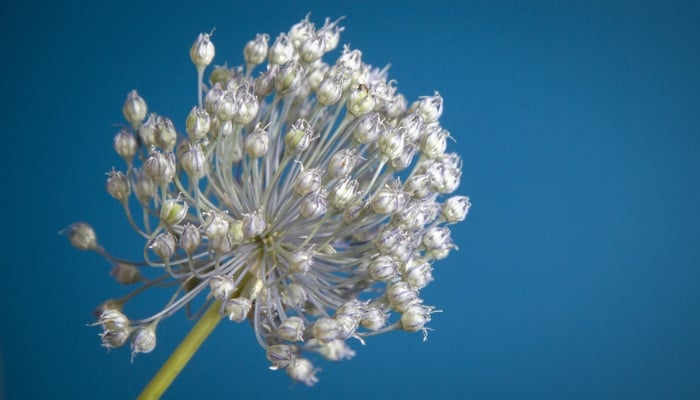
Onion grass (Allium vineale) is a lawn weed, and confusingly, is nicknamed wild garlic. Similar to chives, onion grass leaves are long and cylindrical with a hollow center, but they have bell-shaped flowers of pink or white compared to the globular purple flower heads of chives.
They also grow larger than chives (10-24 inches) at up to 28 inches tall.
2. Meadow Garlic
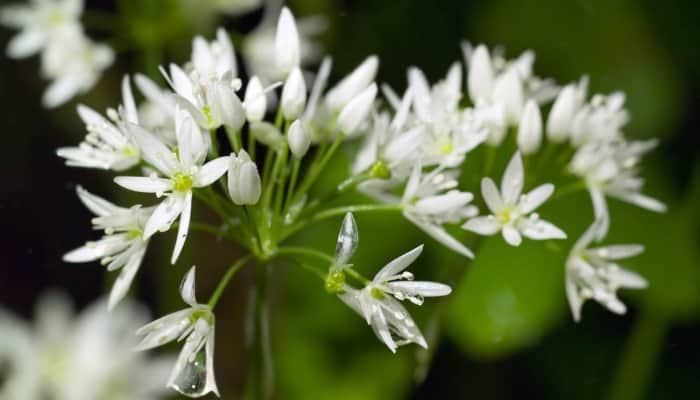
Meadow garlic (Allium canadense), also called wild onion, doesn’t possess the hollow leaves that chives do. It is also considered an invasive weed, unlike chives, which are of course classified as well-loved herbs!
This lawn weed grows to a height of 10-12 inches and produces pink or white star-shaped flowers. Despite the name, the edible leaves are onion-scented like chives.
3. Society Garlic
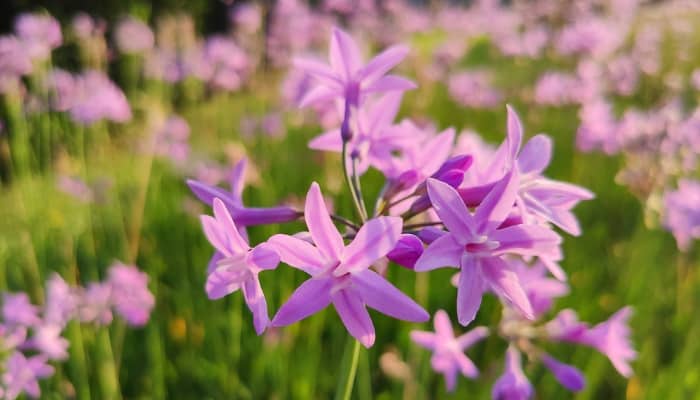
This is a clump-forming groundcover with flat and narrow grass-like leaves of dark green. Like chives, society garlic (Tulbaghia violacea) grows to a nearly identical average height of between 12 and 20 inches and has a spread of 12 inches.
Unlike the deep purple, dense drumstick blooms of chives, however, the flowers of society garlic develop lilac tubular flowers with six-pointed stars on the end.
4. Three-Cornered Leek
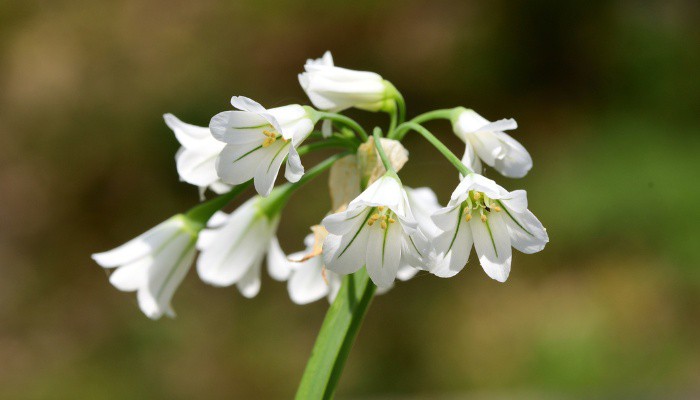
Unlike the cylindrical foliage of chives, three-cornered leeks (Allium triquetrum) are named for their distinctive pyramidal stems that reveal a triangle center when cut.
This bulbous flowering plant produces snowdrop-like bell-shaped flowers, and the entire plant emits a scent of chives, onion, and garlic when crushed.
The roots of three-cornered leeks are a handy tell apart from chives as they tend to taste slightly more sweet and watery.
5. Scallions
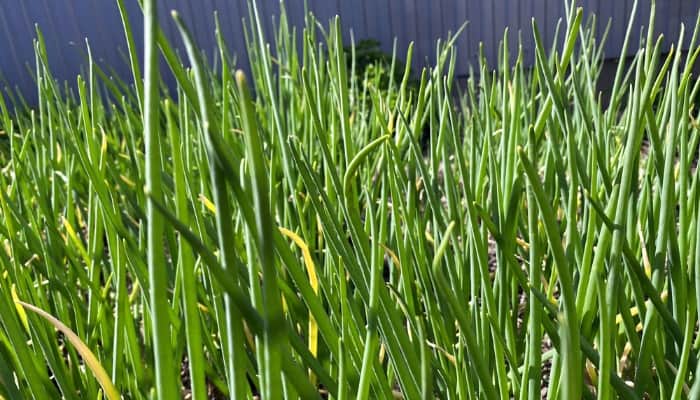
Also known as green onions, scallions are mostly bright green non-bulbing onion plants with a slender, elongated white shaft.
Scallions have a noticeably stronger oniony taste compared to chives, but this is still mild compared with traditional white and yellow onion bulbs. This plant also grows to a similar height to chives, between 10 and 24 inches tall.
6. Spring Onions
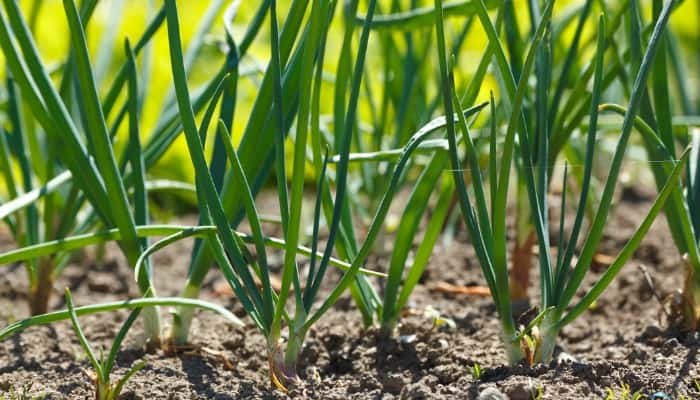
Spring onions grow to a similar height to chives (up to 20 inches) though they have a larger, much more globular bulb. Spring onion plants are also green and white while the entire chive plant is uniformly green.
While chives have singular hollow stalks, spring onions, like green onions, can grow both in singular form or in clumps, depending on the variety, and grow in layered stalks of overlapping leaves.
7. Shallots
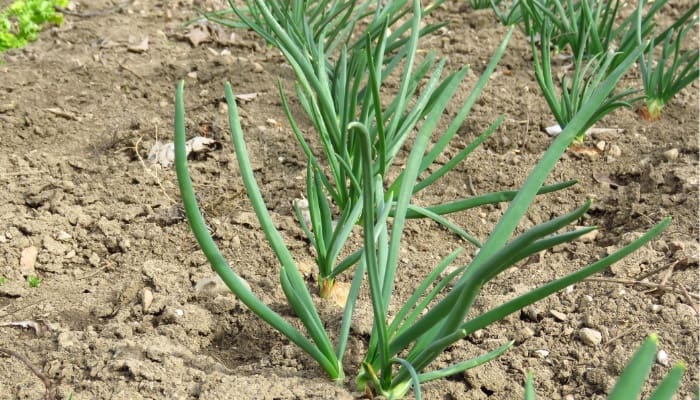
Shallots (Allium cepa var. aggregatum) only grow 12-24 inches tall and form thick cylindrical leaves that taper to a blunt point. Unlike chives, they develop large bulbs with a distinctly oblong shape, like an egg, with two tapered ends.
Unlike purely white chive bulbs, shallots are housed in a colorful papery casing that can range from pink and red to coppery-gold shades.
Each plant develops two or more bulbs of translucent flesh lined with purple or gold rings, depending on the variety, similar to onions.
8. Mountain Death Camas
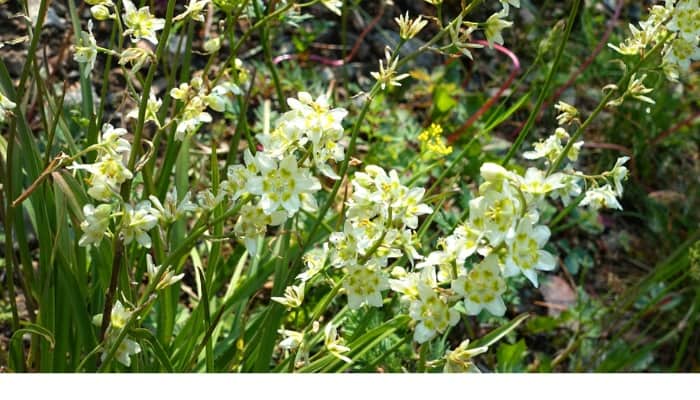
All parts of this pretty wildflower are deadly poisonous with the seeds being the most potent. Mountain death camas (Anticlea elegans) belong to the lily family and produce cream/white to greenish star-shaped flowers on clustered spikes between June and August.
This wildflower can grow anywhere between 6 and 36 inches tall, and like chives, the basal foliage is slender and grass-like with a similar mid-green color.
9. Japanese Garlic
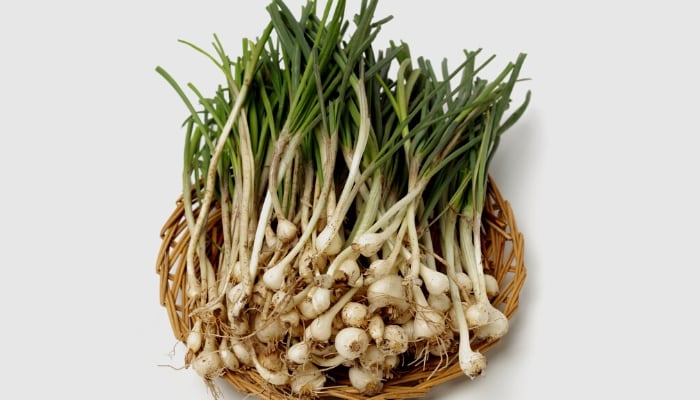
Japanese garlic (Allium macrostemon) is technically part of the onion family and has small, rounded white bulbs and is nicknamed long-stamen chive, which can be confusing to say the least!
Depending on the variety, leaves may be strap-like, cylindrical, or triangular. If the leaves make it hard to tell them apart, an obvious distinction from chive plants is that Japanese garlic features a top cluster of small white flowers which can either be bell or star-shaped and spiky.
10. Common Rush
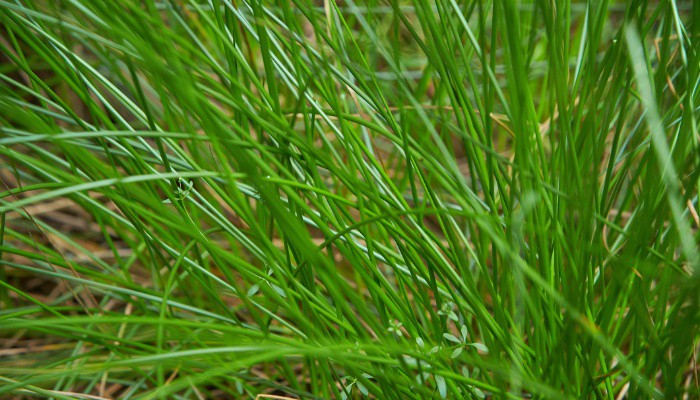
Also known as sugar grass, this type of ornamental plant features similarly slender lush green, grass-like leaves, but it grows in an arching fan-like spread, unlike upright chive clusters.
Common rush (Juncus effusus) also sends out brownish-yellow flowers just below the tips of the stems from July to September and can grow up to 4 feet tall with good care, unlike chives whose leaves will max out around 2 feet tall.
Chives Identification
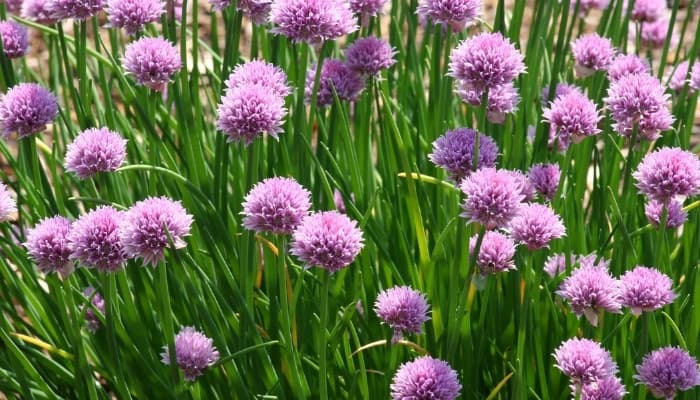
Still a tad confused as to what real chives actually look like? Don’t worry. We’ve got a few pointers to help you distinguish the genuine wild chives in your yard or local meadows from the copycat plants.
Common chives…
- Have a subtle light oniony smell (not overpowering).
- Typically feature large spherical puffball-like blooms at the apex of the stem in purple-mauve or lavender-blue colors (like colorful lollipops!) with individual petals measuring approximately ½ inch long.
- Measure somewhere between 10 and 24 inches tall, though most wild chives are typically 12-18 inches tall and wide.
- Have very small slender bulbs that barely round out at the bottom compared to similar-looking plants.
- Resemble a tight clump of grass with cylindrical leaves.
- Are commonly found growing in USDA Grow Zones 3-9.
- Grow noticeably taller than the surrounding grass and are darker and more vibrant green too.
- Flower between May and August.
Chive Varieties
There are a few different varieties of chives ranging in size and flavor. You’re undoubtedly familiar with common chives you might find at your local store or farmer’s market, but have you heard of Giant Siberian chives?
Let’s look at the different types to find out more.
Common Chives (Allium shoenoprasum)
The most popular chive variety grows roughly 10-12 inches tall topped with globular lilac-lavender flower heads.
Dice up the tubular leaves and immature flower buds for use in soups, stews, salads, and stir fry dishes or to make chive bread, chive fries — you name it!
Garlic Chives (Allium tuberosum)
Also known as Chinese chives, garlic chives possess a stronger taste that is a combination of onion and garlic flavor. They grow up to 24 inches tall.
Unlike regular chives, this variety has flat grass-like leaves and produces tiny white florets at the top of each stem from late summer to early fall.
Giant Siberian Chives (Allium ledebourianum)
Giant Siberian chives are similar to common chives in most respects other than size. This variety has the same cylindrical leaves and mauve-purple flower heads but grows up to 3 feet tall upon blooming.
Giant Siberian chives also have a more pungent onion and garlic flavor and scent, making them great companion plants as they repel quite a handful of insects!
Siberian Garlic Chives (Allium nutans)
Nicknamed blue chives, the Siberian garlic variety of chives produce distinct blue-green teal-colored foliage. They also produce larger bulbs and leaves compared to any other chive type.
The individual florets on this variety are also finer and smaller, giving the globular pinkish-purple flower heads a slightly spikier look.
Closing Thoughts
As you can see, there are quite a few cultivated vegetable varieties, accent plants, and even wildflowers that cleverly masquerade as the common chive plant.
Fortunately, there are plenty of giveaway traits to tell them apart (once you know what to look for). This is especially important when it comes to its poisonous lookalike — the toxic wildflower mountain death camas.
There are also four main types of chive plants, each with slightly differing flavors, sizes, and flowers, though our identification tips should give you a baseline knowledge of the common chive traits.
